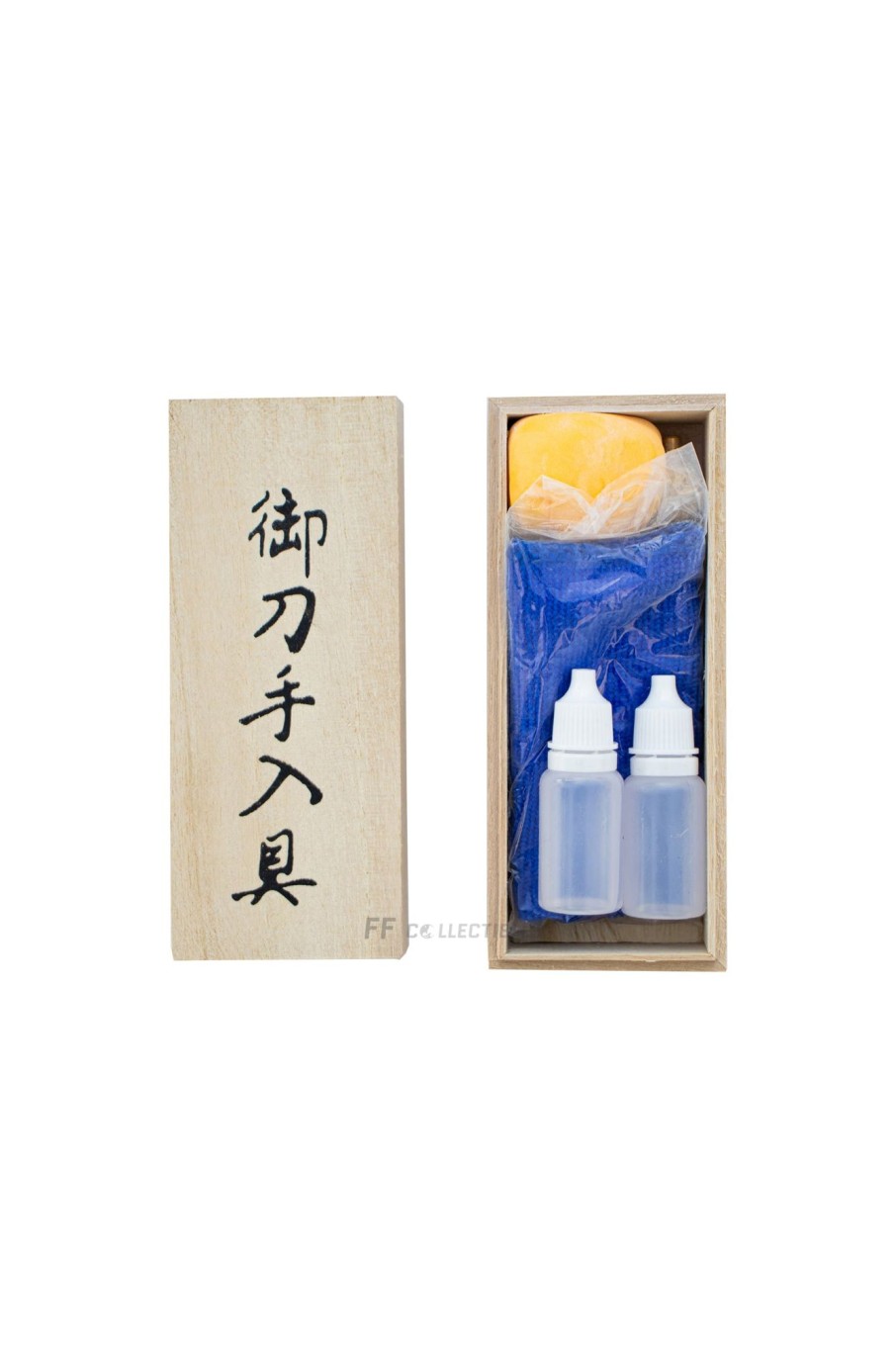Sword Accessories FF COLLECTIBLES | Traditional Japanese Sword Maintenance And Cleaning Kit
$18.21 $15.66
Sword Accessories FF COLLECTIBLES | Traditional Japanese Sword Maintenance And Cleaning Kit

Traditional Japanese Sword Maintenance And Cleaning Kit
A Traditional Maintenance Kit Containing All The Necessities For You To Clean And Care For Your Loved Blades.
All Characters Are Written In Japanese In Kanji.
御刀手入具 “O-Gatana Teire-Gu” Meaning Cleaning Kit For Katana
Suitable For Traditional Swords And Blades, This All-In-One Maintenance Kit Is A Must For Sword Collectors And Owner’S Looking For Proper Tools To Care For Their Pride And Joy.
Description:
This Maintenance Kit Comes With Following Tools:
- Choji Abura, Two Bottles Of Premium Choji Blade Oil Made From Japanese Cloves And Mixed With Mineral Based Oil. A Special Oil That Protects And Preserves Your Sword From Rust By Creating A Barrier Of Protection Between The Steel And The Outside Elements.
- Mekugi Nuki, A Traditional Brass Hammer Used To Take Off The Mekugi (Bamboo Pin) From A Katana.
- Uchiko, A Chalk Powder Ball Wrapped In Orange Cloth, Used To Clean The Oil Off Your Blade. It Is Made From Ground Hazuya And Jizuya Stone Which Are Polishing Stones That Act As A Soft Abrasive.
- Mekugi, Two Spare Bamboo Pins That Secure A Traditional Katana Together.
- A Blue Microfibre Cloth Which You Can Use To Wipe Clean Your Blade From Any Dust Or Impurities
- A Wooden Storage Box With Calligraphy In Japanese Kanji
How To Use:
Maintaining A Katana Is Quite A Straightforward Task.
Good Maintenance Is Basically Ensuring There Is Always A Light Layer Of Oil On The Blade, This Prevents Moisture From Getting In And Rusting The Surface Of The Steel. This Is Most Important For Carbon Steel Blades As They Are Not Corrosion Resistant Like Stainless Steel And Can Be Susceptible To Oxidation.
- Clean The Blade With The Microfibre Cloth, Try Not To Leave Any Residue Or Fibres Behind On The Blade When Cleaning.
- Once Free Of Oil, Powder Blade With Uchiko Ball, This Soaks Up Any Left Over Moisture And Acts As An Abrasive Which Cleans The Steel As It Is Wiped Off. Do This By Tapping The Ball Against The Side Of The Blade Moving Towards The Tip And Applying Powder To The Whole Blade.
- Use The Cloth Again And Wipe It Down The Blade.
- Now Reapply A New Layer Of Oil, Dab A Small Amount Of Oil On The Cloth, Gently Move The Cloth Down The Blade Ensuring Every Bit Of The Blade Comes Into Contact. You Can Inspect The Blade Against The Light To Check If Any Areas Are Missing.
- When The Entire Blade Is Covered In A Light Layer Of Oil, You Are Finished.
For Disassembly
Most Traditional Japanese Katanas Use Two Bamboo Mekugi Pegs To Hold The Blade In Place, They Are Made So That They Can Be Easily Removed To Inspect The Tang Which Is The Hidden Part Of The Blade That Extends To The Handle.
- Unscrew The Top Of The Mekugi Nuki, The Brass Hammer, To Reveal The Punch.
- Find The Side Of The Katana Handle Where The Mekugi Is Visible, This Is The Side The Mekugi Will Come Out. Flip The Handle Over And Push Anything Wrapping The Handle Away So You Can Hammer The Mekugi Out.
- Hold The Punch Over The Mekugi And Hammer The End With The Mekugi Nuki.
- Once Mekugi Is Removed, Handle And Fittings Can Also Be Removed. This Might Be Difficult For Tight-Fitting Katanas.
- To Re-Assemble, You Use Slide The Fittings Back Into Place And Reuse The Old Mekugi If No Problems Or Use The Mekugi That Come In The Kit.
This Is A Must Own Maintenance Kit For Any Lover Of Swords!
Product Is Absolutely Brand New.
Made With The Highest Quality Materials And Crafted With Special Attention.
In Limited Supply Due To Extremely High Demand.
‘
Be the first to review “Sword Accessories FF COLLECTIBLES | Traditional Japanese Sword Maintenance And Cleaning Kit” Cancel reply
Related products
Keychains And Mini Replicas
Keychains And Mini Replicas FF COLLECTIBLES | One Piece Ame No Habakiri Sword Keychain
Premium Sword Stands
Sword Accessories FF COLLECTIBLES | Premium Single Sword Stand – Bamboo
Premium Sword Stands
Sword Accessories FF COLLECTIBLES | Premium Black Dragon Single Sword Stand
Keychains And Mini Replicas
Keychains And Mini Replicas FF COLLECTIBLES | One Piece Sandai Kitetsu Sword Keychain
Keychains And Mini Replicas
Keychains And Mini Replicas FF COLLECTIBLES | World Of Warcraft Frostmourne Mini Replica (30 Cm)
Keychains And Mini Replicas
Keychains And Mini Replicas FF COLLECTIBLES | One Piece Yubashiri Sword Keychain
Keychains And Mini Replicas
Keychains And Mini Replicas FF COLLECTIBLES | Sword Art Online Black Dark Repulser Sword Keychain


























Reviews
There are no reviews yet.